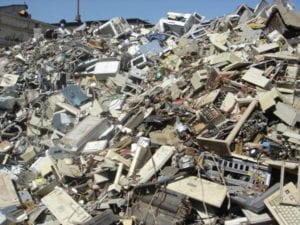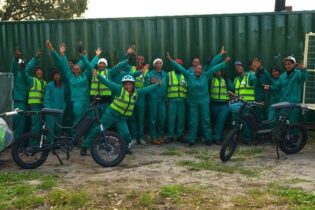The second National e-waste Collection Day, which took place on 13 July 2013 at 631 points nationwide, has added to the growing collection of e-waste by eWaste Association of South Africa (eWASA) member companies for responsible management and recycling. Chantelle Mattheus speaks to eWASA chairman, Keith Anderson, on the changing e-waste dynamic in the South Africa.
Unique in its material composition, e-waste items contain both valuable and hazardous materials that can cause harm to the environment and human health if not handled correctly. In general, the valuable bits help to fund the expensive hazardous waste treatment and or disposal of hazardous items such as mercury bearing lamps (CFLs and florescent tubes), batteries, and lead-containing glass found in old TV and computer monitors. “E-waste is all waste electrical and electronic (WEEE) and includes anything that uses a battery or electricity to work. Thus, large household appliances, consumer electronics, small appliances, PCs, Macs, phones, chargers, compact florescent lamps, batteries, iPads, toys, gaming consoles, TVs, printers, the lists goes on and on,” explains Anderson. As defined by Department of Environmental Affairs (DEA), the “e-waste category” means the categories of e-waste as defined in the DEA draft Waste Categorisation System for WIS Reporting:| 01 | Large household appliances | Washing machines, dryers, refrigerators, air conditioners, etc. |
| 02 | Small household appliances | Vacuum cleaners, coffee machines, irons, toasters, etc. |
| 03 | Office, information &communication equipment | PCs, laptops, mobiles, telephones, fax machines, copiers, printers etc. |
| 04 | Entertainment &consumer electronics, and toys, leisure, sports & recreational equipment, and automatic issuing machines | Televisions, VCR/DVD/CD players, Hi-fi sets, radios, etc., and electric train sets, coin slot machines, treadmills etc., and vending machines, parking ticket equipment etc. |
| 05 | Lighting equipment | Fluorescent tubes and lamps, sodium lamps etc. (except incandescent bulbs, halogen bulbs) etc. |
| 06 | Electric and electronic tools | Drills, electric saws, sewing machines, lawn mowers etc. (except: large stationary tools/machines, etc.) |
| 07 | Security & health care equipment | Surveillance and control equipment (e.g. CCTV cameras, scanning equipment), and medical instruments and equipment (e.g. x-ray and heart lung machines) etc. |
| 08 | Mixed WEEE |
The biggest risks faced with regards to e-waste are illegal dumping in landfill sites that lead to contamination of the soil and rivers, as well as “cherry picking” the value items and then illegally discarding the residual waste, warns Anderson.
According to him, one of eWASA’s key objectives is to raise awareness amongst both business and consumers. “In addition we want to help our members to continue to grow collection rates and are using collection days as a way to raise awareness and increase collection rates.” As mentioned, the second nation e-waste collection day took place on Saturday 13 July 2013. Anderson believes that awareness initiatives such as the collection day are of pivotal importance in winning the growin battle against e-Waste. “Education, awareness and ease of disposal are all key drivers that can positively influence consumers in the safe disposal of their e-waste,” says Anderson, adding that this program speaks to all of those issues. It also helps further establish the EWASA brand as a trusted advisor. However recovery and/or recycling needs to be dealt with on a regular basis, as opposed to only on collections days. To this end, EWASA, through its marketing efforts is increasing its membership base and national footprint on a monthly basis. Each of our members sign and are governed by a good of conduct which underpins “best practice”, says Anderson. “Later this year we will be launching a series of training courses aimed at business and potential new entrants into the recycling sector. In October we are planning a national road show, focussing specifically at the Youth and job creation in our sector.” He adds that most of the collection points are permanent collection points. “mywaste.co.za would pinpoint the closest drop-off point to you.” Challenging context Further challenges faced by the industry as a whole include the lack of a strong legal framework, fly by night operators, illegal burning of cables to recover copper, says Anderson. He is clear that the only way to overcome these challenges is a multi-faceted approach that includes working with all the stakeholders from Government through to the private sector and the consumer in educating them on the problems of e-waste. In addition, “raising the level of professionalism and standards of our membership base and assisting them in penetrating the market by offering their services at affordable prices and convenient “drop off points” nationally,” says Anderson. He adds that a focus on introducing new technologies and standards and assisting in the creation of green jobs aimed at the youth and the SMME market are also important. Step 1 however remains the creation of awareness, according to Anderson, and therefore education is very important at many levels, from primary school, high school, FET, business and consumer levels. “This also has to done on an on-going basis to create a change in the mind-set of the consumer.” The cause however is not lost yet. “Far from a lost cause the e-waste industry has room to create sustainable jobs and can only grow,” concludes Anderson.







